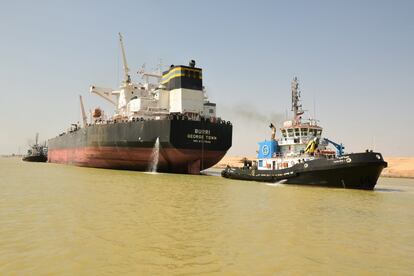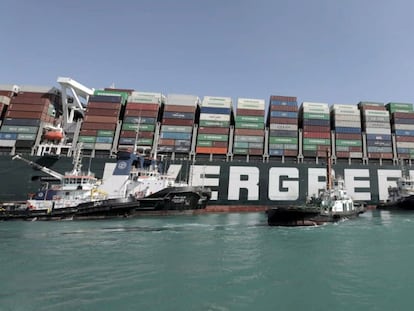Two tankers collided in Egypt’s Suez Canal, briefly disrupting traffic in the vital waterway
The authorities blamed the strong currents in that stretch of the canal for the crash

Two tankers carrying oil products and liquefied natural gas collided in a single-lane stretch of the Suez Canal, briefly disrupting traffic through the global waterway before it was cleared, Egyptian authorities said Wednesday.
The Suez Canal Authority said in a statement that the BW Lesmes, a Singapore-flagged tanker that carries liquefied natural gas, suffered a mechanical malfunction in its propulsion and steering systems on Tuesday night. It ran aground after which the Burri, a Cayman Islands-flagged oil products tanker, collided with it at the 144 kilometer (89 mile) -mark of the waterway, the canal said.
The collision disrupted traffic for several hours while the canal authority deployed tugboats to tow the two tankers away. The two were part of a convoy of vessels transiting through the canal from the Mediterranean Sea to the Red Sea.
“Traffic will go back to normal in both directions within the coming hours,” Adm. Ossama Rabei, the head of the canal authority, said earlier Wednesday, before tugboats removed the tankers and cleared the waterway.
The authorities blamed the strong currents in this part of the Suez Canal for the collision. The canal services firm Leth Agencies said the incident delayed the transit of 21 southbound vessels that were scheduled to pass through the waterway on Tuesday.
About 10% of world trade flows through the canal, a major source of foreign currency for the Egyptian government.
MarineTraffic, a vessel tracking service provider, released a time-lapse video of the incident that showed the Burri turning to port and colliding with the BW Lesmes, which was already grounding across the waterway.
Built in 2018, the Burri is 250 meters (820 feet) long and 44 meters (144 feet) wide. The BW Lesmes was built three years later and is 295 meters (968 feet) long and 46.43 meters (152 feet) wide, according to MarineTraffic.
Canal authorities said they managed to refloat and tow away the BW Lesmes. They also removed the Burri from the waterway. The authority posted images showing the Lesmes anchored in the canal, while others showed the Burri being towed away.
“All crew members are safe and accounted for and there were no injuries or any reports of pollution,” BW LNG AS, the operators of the BW Lesmes, said in a statement.
Rabei said initial inspections showed there was no significant damage to the tankers, or pollution at the site. A technical team from Oslo, Norway, was to arrive at the vessel later Wednesday to investigate, BW LNG AS said.
The incident was the latest case of a vessel reported stuck in the crucial waterway. A flurry of ships have run aground or broken down in the Suez Canal over the past few years. Earlier this month, a tugboat sank in the canal after it collided with a Hong Kong-flagged tanker.
Tuesday’s collision happened at the same section of the canal where the Panama-flagged Ever Given, a colossal container ship nearly 400 meters (yards) long, crashed into a bank on a single-lane stretch of the canal in March 2021, blocking the waterway for six days and disrupting global trade. The Lesmes is much shorter than the Ever Given.
The canal, which connects the Mediterranean and the Red seas, was opened in 1869. It provides a crucial link for oil, natural gas and cargo. The canal authority operates a system of convoys, consisting of one northbound and one southbound per day.
According to the Suez Canal Authority, last year 23,851 vessels passed through the waterway, compared to 20,649 vessels in 2021. Revenue from the canal in 2022 reached $8 billion, the highest in its history.
Sign up for our weekly newsletter to get more English-language news coverage from EL PAÍS USA Edition
Tu suscripción se está usando en otro dispositivo
¿Quieres añadir otro usuario a tu suscripción?
Si continúas leyendo en este dispositivo, no se podrá leer en el otro.
FlechaTu suscripción se está usando en otro dispositivo y solo puedes acceder a EL PAÍS desde un dispositivo a la vez.
Si quieres compartir tu cuenta, cambia tu suscripción a la modalidad Premium, así podrás añadir otro usuario. Cada uno accederá con su propia cuenta de email, lo que os permitirá personalizar vuestra experiencia en EL PAÍS.
¿Tienes una suscripción de empresa? Accede aquí para contratar más cuentas.
En el caso de no saber quién está usando tu cuenta, te recomendamos cambiar tu contraseña aquí.
Si decides continuar compartiendo tu cuenta, este mensaje se mostrará en tu dispositivo y en el de la otra persona que está usando tu cuenta de forma indefinida, afectando a tu experiencia de lectura. Puedes consultar aquí los términos y condiciones de la suscripción digital.
More information
Últimas noticias
Most viewed
- Sinaloa Cartel war is taking its toll on Los Chapitos
- Oona Chaplin: ‘I told James Cameron that I was living in a treehouse and starting a permaculture project with a friend’
- Reinhard Genzel, Nobel laureate in physics: ‘One-minute videos will never give you the truth’
- Why the price of coffee has skyrocketed: from Brazilian plantations to specialty coffee houses
- Silver prices are going crazy: This is what’s fueling the rally










































